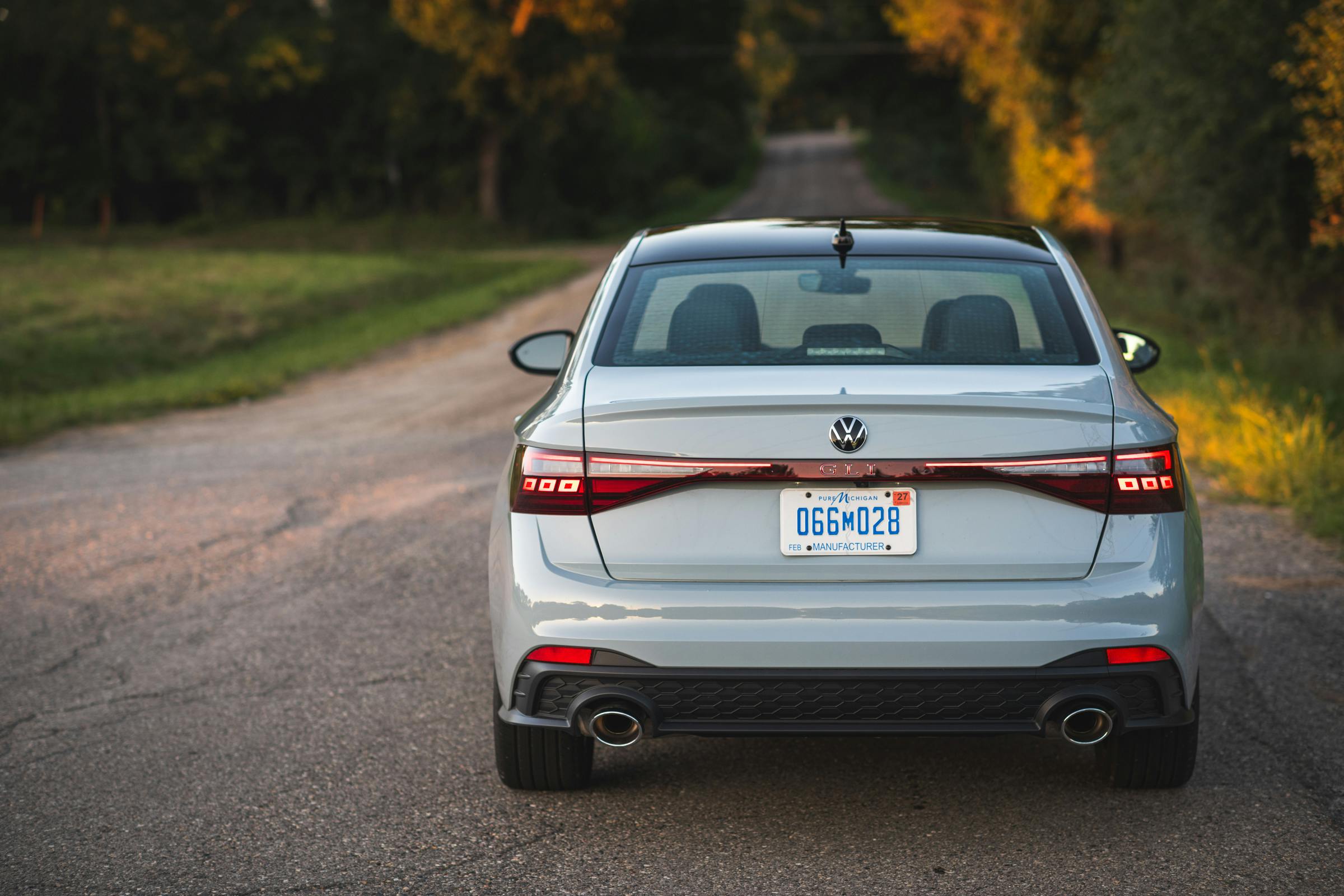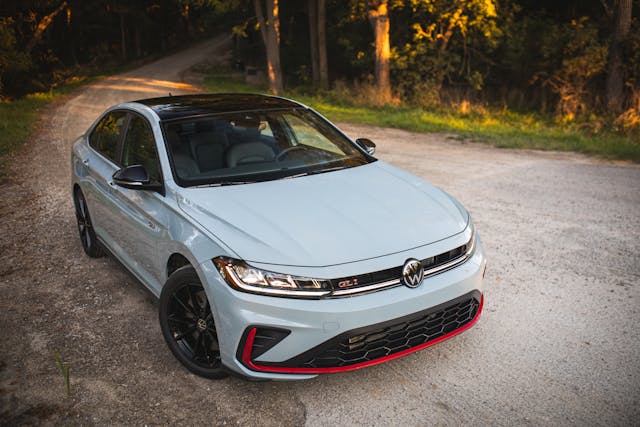Media | Articles
2025 VW Jetta GLI Review: Tending to the Flame
Last year marked the Jetta GLI’s 40th anniversary. Volkswagen’s formula for the debut 1984 model year was much the same then as now: Drop the spunky Golf GTI powertrain into the larger, three-box Jetta sedan. That original effort was deeply appealing here in the U.S., especially amid an era that Hagerty senior editor Kirk Seaman has called “an automotive wasteland . . . a vast and desolate landscape populated by automobiles of the terminally mediocre variety.” The GLI was thus a revelation—practical, polished, and exhibiting the dynamic sophistication of a BMW or Audi, albeit with a simpler, more economical interior. The average car in 2025 is pretty darned good, but with sedans and entry-level sports cars becoming increasingly endangered, the VW Jetta GLI still represents a rare treat: It is a lively and affordable sedan specifically made for enthusiasts.
Volkswagen refreshed the Jetta for 2025, its second such update since the current-generation model launched in 2018. The GLI made its appearance the following year. Which means the MQB-platform bones and 228-hp, 258 lb-ft EA888 turbo-four engine are, well, old. That’s not necessarily a bad thing, as the GLI is more or less the outstanding, last-generation (Mk. 7) GTI with more space and an enclosed trunk. The mechanicals are all carryover from last year, but the 2025 GLI gets an all-new front- and rear-end design, an updated interior with a new 8-inch center screen and touch-sensitive climate controls, and a mere $930 price increase from last year’s version. Starting price is now $33,940 for a fully loaded GLI Autobahn, which is the only trim available. The sole option package available is the $650 Black Package, which adds a black roof and mirror caps and was included with the tester we borrowed for this review. Our loaner also came with one of two new paint colors for 2025—an attractive, icy-blue finish known as Monument Gray ($450).




Unlike that original GLI from the ’80s, which entered the fray against the Mercedes 190E, BMW 325e, and Audi 4000, the GLI’s two main competitors these days are from Asia: the Honda Civic Si and the Hyundai Elantra N. Part of that shift is a consequence of these luxury brands moving even further upmarket in search of profit, but the other part is the rise of Japanese and Korean cars over the last four decades. Today, Honda and Toyota lead America’s sedan market with the Accord and Camry, but Kia and Hyundai still lay some claim to the space, which VW says currently represents 20 percent of the overall new-car market. At the media event we attended for this GLI in southeast Michigan, VW reps stressed that the Jetta’s role as an entry point into the brand was even more important than the model’s standalone profitability.
Specs: 2025 Volkswagen Jetta GLI Autobahn
- Price: $33,940 / $35,045 (base / as-tested)
- Powertrain: 2.0-liter turbocharged I-4; seven-speed dual-clutch automatic transmission (six-speed manual available at no cost)
- Output: 228 hp; 258 lb-ft
- Layout: Front-engine, four-door, five-passenger, front-wheel-drive sedan
- Weight: 3311 pounds
- 0–60 mph: 5.6 seconds (est., with DSG)
- Top Speed: 126 mph (limited)
- EPA Fuel Economy: 25/35/29 mpg (city/hwy/combined, with DSG)
- Competitors: Honda Civic Si, Hyundai Elantra N, Subaru WRX
All that is to say, the GLI’s main role is to get young people excited about the VW brand, so they’ll stick around when they need something Tiguan- or Atlas-sized. And how exciting is the GLI? The powertrain packs a whole lot more punch than the Civic Si’s, for one. While the Civic’s aloof, droning 200-horse 1.5-liter takes its time, the GLI’s 2.0-liter responds quickly with generous torque and smooth power delivery across the rev range.



The VW’s six-speed manual is friendly and easy to operate, if not as precise as the Honda’s, but it’s also not especially rewarding to manipulate. The take rate for the three-pedal option is about 40 percent for the GLI, which means North Americans really want it, considering VW’s seven-speed dual-clutch automatic is essentially faultless here. (For 2025, both the stick and DSG cost the same.) VW dropped the manual gearbox for the 2025 GTI, citing an extremely low global take rate, despite a 50 percent figure on these shores. (The GLI, being built in Mexico rather than Germany and exclusive to North America, gives VW of America more autonomy in gearbox availability.) The Civic Si is manual-only, while the Elantra N comes with a choice of six-speed stick or eight-speed dual-clutch auto. The Elantra’s engine is peakier and sounds raspier than the GLI’s, and its manual is a bit more feelsome and heavy-duty than the Volkswagen’s, whose light clutch and ropey throws don’t especially thrill.
Marketplace
Buy and sell classics with confidence

Chassis-wise, the GLI impresses almost across the board. Turn-in is quick and crisp, and a tight turn radius makes finding parking spots in narrow lots a breeze. A standard electronic limited-slip differential that can send 100 percent of torque to either front wheel, in concert with brake-based torque vectoring, lets the GLI scrabble out of corners with zeal. Brakes—borrowed from the outgoing-generation Golf R, yield outstanding bite and feel throughout the pedal travel. Standard adaptive dampers (DCC, in Volks-speak) offer some ride comfort adjustability across Comfort, Normal, and Sport drive modes, but even in its stiffest setting, the dampers do not punish passengers. While simultaneously under heavy steering load and shifting pavement, the GLI can feel a touch unsettled, but the feedback in these situations is never jarring. Compared with the more inert and unflappable Mk. 8 GTI, it’s actually welcome. The Civic Si is perhaps more composed, and the Elantra N more spirited, but the GLI strikes the best balance between eagerness and livability. A weak point: variable-ratio steering that doesn’t always feel natural, despite decent road feedback. The standard 18-inch Hankook tires, too, disappoint, getting squishy with a bit of heat in them.
That middle position on the spectrum also applies to the GLI’s design, which, despite its sportier refresh for 2025, comes nowhere close to the Elantra N’s aggro face and sharp, faceted body lines. Being that VW generally builds sensible cars for sensible people, this should come as little surprise, but the new GLI nevertheless looks more purposeful this time around. The upper grille is narrower, and the lower grille gets widened, with a full-width red accent that gels far better with the front end than the outgoing car’s lipstick-like foglight accents. The rear achieves a similar effect with an end-to-end light bar and a taller trunklid spoiler.




If the 2025 GLI’s exterior is an overall improvement, the interior is a mixed bag. Let’s start with the bad: Touch-sensitive climate controls are now standard. VW has made improvements to its haptic-feedback controls since the Mk. 8 GTI and ID.4 electric crossover launched a few years back (they’re now illuminated at night, for one, and less sensitive to accidental activation), but even still, these designs demand too much driver attention while the vehicle is in motion. Simple buttons, knobs, or switches are still what most people want. As for other misses, the interior quality is still wanting for a $35,000 car—a common refrain with the American-market Jetta for the last couple of decades. The front seats lack the Si’s and Elantra N’s supportive bolstering, door handles squish and flex when pulled on, and the panels on the rear doors wear cheap plastic compared with the soft fronts.



On the plus side, features are plentiful and the Jetta is engineered for brilliant cargo capacity, given the compact-car footprint. The GLI comes standard with a generous suite of active safety equipment, a massive panoramic sunroof, heated and ventilated front seats with leather, a power driver’s seat with memory, heated steering wheel, three USB-C charging ports, rain-sensing wipers, keyless entry, remote start, a premium BeatsAudio sound system, and wireless charging. Best of all, perhaps, is a spare tire underneath the floor of the enormous trunk.

VW’s infotainment system, displayed on a new 8-inch center screen, poses no major obstacles. Controls are primarily via touch, along with a physical volume and tuner knob. Menus are simple to navigate, and the sound system has notably good bass thump. Back-seat passenger space is top-notch for a compact car, at least as good as the Civic in this regard, and storage space in door pockets and the center console is excellent. Practically speaking, it’s at least as livable as the GTI, whose sole advantage is the utility of a hatchback.
This is a $35,000 car all told, which indeed sounds like a lot for a Jetta. No doubt, the GLI was a much better deal when it was offered in lesser trims and with an all-in price under $30,000. Even the Civic Si, however, now costs $31,000, and the Elantra N starts north of $35,000. The Honda is perhaps the better bargain, and the Elantra more of an attention-getter, but the GLI is a rewarding car to drive and a welcome player in the mainstream sport sedan segment. It’s no longer the bright candle in a dark room that it once was, illuminating an otherwise grim automotive wasteland, but we’d be the first to mourn its light, should it ever go out.
2025 Volkswagen Jetta GLI Autobahn
Price: $33,940 / $35,045 (base / as-tested)
Highs: Torquey and responsive engine. Competent dual-clutch automatic. Powerful, responsive brakes. Tons of standard features.
Lows: Not cheap, and no lesser trims from which to dull the MSRP sting. Touch-sensitive climate controls are the answer to a question nobody asked. Interior focuses more on flash than top-quality fitment.
Summary: The 2025 Jetta GLI keeps aloft a sport-sedan torch that goes back four decades. Its powertrain and chassis remain at the top of the heap, but we pine for a time when a solid, no-nonsense interior was a VW selling point.











































That dumb looking distracting monitor grafted to the dashboard WILL keep me from buying what looks otherwise to be a very nice car. VW should make that an option delete for those of us who drive cars on the road and operate computers in our offices.
Agree 100%. Added to that, what’s the point of the idiotic decision to have touch sensitive climate controls? More stuff to go wrong after the warranty expires, so the dealer can ding the customer for a hefty repair bill?
Nice to see it isn’t quite the Golf GTI interior level of haptic and no buttons. I do think the Elantra N gives this car some steep competition. If this was lower in price it would be a nice middle ground.
I believe the graffiti on the screen is from a persons phone background when they are linked. It does that on my brother’s 2024 Jetta infotainment system.
Anyhow, I’m looking forward to picking up my 2025 GLI in a few weeks.
—
2025 Jetta GLI
Manual Transmission
Oryx White / Black Package